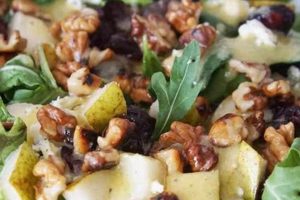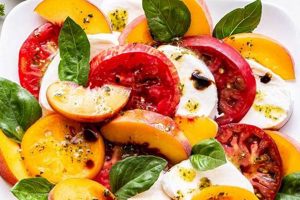Flavorful and refreshing salads centered around various lettuce types, such as crisp romaine, butter lettuce, or peppery arugula, offer a versatile culinary canvas. These dishes can incorporate a wide range of ingredients, from fresh vegetables and fruits to proteins, cheeses, nuts, and seeds, dressed with complementary vinaigrettes or creamy dressings. An example might include grilled chicken atop romaine lettuce with crunchy croutons, Parmesan cheese, and a classic Caesar dressing.
Salads built on a foundation of lettuce provide significant nutritional value, offering vitamins, minerals, and fiber. They contribute to a balanced diet, promoting digestive health and overall well-being. Historically, lettuce has been cultivated for centuries, evolving from a simple leafy green to the diverse array of varieties available today, allowing for a wide spectrum of salad creations to suit various palates and dietary needs.
This exploration will delve into specific components and techniques that elevate lettuce-based salads from simple to extraordinary. Topics covered will include selecting the ideal lettuce variety, creating balanced flavor profiles, and mastering dressing emulsions, ultimately guiding the reader toward crafting exceptional salads.
Tips for Exceptional Lettuce Salads
Creating a truly delicious lettuce salad involves more than simply tossing ingredients together. Attention to detail, from ingredient selection to assembly, elevates the final dish. The following tips offer guidance on achieving optimal flavor and texture.
Tip 1: Select the Right Lettuce. Different lettuce varieties offer unique flavors and textures. Crisp romaine provides a sturdy base for heavier dressings, while delicate butter lettuce complements lighter vinaigrettes. Consider the overall flavor profile when selecting the lettuce.
Tip 2: Wash and Dry Thoroughly. Properly washing and drying lettuce removes impurities and ensures the dressing adheres evenly. Excess moisture can dilute the dressing and make the salad soggy.
Tip 3: Balance Flavors and Textures. A successful salad incorporates a variety of flavors and textures. Combine crunchy elements like nuts or croutons with softer ingredients like tomatoes or avocado. Balance sweetness with acidity and savory notes.
Tip 4: Dress Strategically. Add dressing just before serving to prevent the lettuce from wilting. Toss gently to coat the leaves evenly, using only enough dressing to lightly coat the ingredients.
Tip 5: Utilize High-Quality Ingredients. The freshest ingredients yield the best results. Choose seasonal produce whenever possible for optimal flavor and nutritional value.
Tip 6: Experiment with Homemade Dressings. Homemade dressings offer greater control over flavor and avoid unnecessary additives. Explore various combinations of oils, vinegars, herbs, and spices.
Tip 7: Consider the Occasion. A light and refreshing salad is ideal for a summer luncheon, while a more substantial salad with added protein can serve as a main course.
By following these guidelines, one can consistently create salads that are both flavorful and visually appealing, transforming a simple dish into a culinary experience.
This exploration of essential tips provides a foundation for crafting exceptional lettuce salads. The following section will further enhance understanding by examining common mistakes to avoid.
1. Fresh, High-Quality Lettuce
Fresh, high-quality lettuce forms the foundation of any exceptional lettuce salad. Its importance cannot be overstated, as the lettuce itself contributes significantly to the overall texture, flavor, and visual appeal of the finished dish. The quality of the lettuce directly impacts the salad’s success. Wilted, bruised, or otherwise compromised lettuce detracts from the sensory experience, resulting in a less satisfying meal. Crisp, vibrant lettuce, on the other hand, provides a refreshing crunch and a clean, pleasant taste, enhancing the impact of other ingredients and the dressing. This principle applies across various lettuce types, from the sturdy romaine to the delicate butter lettuce.
Consider the difference between a Caesar salad made with crisp romaine hearts and one made with limp, discolored leaves. The former offers a satisfying crunch and a clean flavor that complements the creamy dressing and savory Parmesan, while the latter results in a soggy, unappetizing salad. Similarly, a delicate salad featuring butter lettuce and fresh berries requires pristine leaves to showcase the subtle flavors and textures. Using subpar lettuce would overwhelm the delicate balance and diminish the overall quality.
Understanding the crucial role of fresh, high-quality lettuce allows for informed ingredient selection and elevates the final product. Prioritizing lettuce quality ensures a satisfying culinary experience, demonstrating a commitment to both flavor and aesthetics. This principle underscores the interconnectedness of ingredient quality and culinary excellence in lettuce salad preparation.
2. Complementary Ingredient Combinations
Complementary ingredient combinations are essential for elevating lettuce salads from simple to exceptional. The thoughtful selection and pairing of ingredients contribute significantly to the overall balance, flavor profile, and textural complexity of the final dish. A successful lettuce salad relies on the synergistic interplay of various components, each playing a crucial role in enhancing the overall sensory experience. Consider a classic Cobb salad: the combination of crisp lettuce, grilled chicken, bacon, tomatoes, hard-boiled eggs, avocado, blue cheese, and a vinaigrette dressing creates a harmonious blend of flavors and textures. The richness of the bacon and blue cheese is balanced by the acidity of the tomatoes and vinaigrette, while the varying textures of the ingredients provide a satisfying contrast.
Understanding the principles of flavor and texture pairing allows for the creation of more dynamic and interesting salads. Balancing sweet and savory elements, incorporating contrasting textures, and considering the interplay of acidity and richness all contribute to a more nuanced and satisfying culinary experience. For instance, pairing peppery arugula with sweet roasted beets, creamy goat cheese, and candied pecans creates a complex and balanced salad. The bitterness of the arugula is offset by the sweetness of the beets and pecans, while the creamy goat cheese adds a contrasting texture and a subtle tang. A light vinaigrette ties the flavors together without overpowering the delicate balance.
Mastering the art of complementary ingredient combinations is fundamental to crafting truly great lettuce salad recipes. Thoughtful ingredient selection and strategic pairing enhance the overall sensory experience, elevating a simple salad to a culinary masterpiece. This understanding empowers culinary exploration and encourages creativity in the kitchen, leading to the development of unique and flavorful salads that delight the palate.
3. Balanced Flavor Profiles
Balanced flavor profiles are fundamental to achieving greatness in lettuce salad recipes. A truly exceptional salad transcends mere ingredient combinations; it orchestrates a harmonious interplay of tastessweet, sour, salty, bitter, and umamicreating a symphony on the palate. This balance prevents any single flavor from dominating, ensuring a nuanced and satisfying culinary experience. The absence of balance can lead to a one-dimensional salad, where excessive sweetness, acidity, or bitterness overshadows other components. Consider a salad with an abundance of tart cranberries and a sharp vinaigrette without a balancing element of sweetness or richness. The resulting dish may be overwhelmingly acidic, failing to showcase the other ingredients. Conversely, a salad overly reliant on creamy dressings and rich cheeses can become cloying without a contrasting acidic or bitter element.
Practical application of this principle requires careful consideration of ingredient selection and proportion. A salad featuring peppery arugula benefits from the sweetness of roasted pears and the salty tang of crumbled goat cheese, creating a balanced flavor profile. The bitterness of the arugula is tempered by the pear’s sweetness, while the goat cheese adds a contrasting salty and tangy note. Similarly, a salad with grilled chicken, crisp romaine lettuce, and a creamy dressing can be enhanced with the addition of crunchy croutons and a squeeze of lemon juice. The croutons add textural contrast, while the lemon juice provides a burst of acidity to cut through the richness of the dressing. These examples illustrate how balanced flavor profiles elevate the overall dining experience, transforming a simple salad into a culinary delight.
Achieving balanced flavor profiles in lettuce salad recipes requires an understanding of the interplay of different tastes and the ability to combine ingredients strategically. This mastery elevates salads from basic to extraordinary, showcasing the potential of this versatile dish. Successfully balancing flavors transforms a simple combination of ingredients into a sophisticated and satisfying culinary creation. It underscores the importance of thoughtful ingredient selection, portion control, and an appreciation for the nuanced interplay of tastes in creating truly exceptional lettuce salads.
4. Appropriate Dressings
Appropriate dressings are essential for elevating lettuce salads from satisfactory to exceptional. The dressing serves not merely as a condiment but as a unifying element, harmonizing the diverse flavors and textures of the salad’s components. A thoughtfully chosen dressing complements the other ingredients, enhancing their individual characteristics while contributing to the overall balance and complexity of the dish. An unsuitable dressing, conversely, can overwhelm delicate flavors or clash with stronger ones, detracting from the salad’s potential. The following facets explore the crucial role of appropriate dressings in crafting truly great lettuce salad recipes.
- Flavor Pairing
The dressing’s flavor profile should complement, not compete with, the other salad ingredients. A light vinaigrette enhances the delicate flavors of fresh greens and herbs, while a creamy dressing complements heartier salads with roasted vegetables or proteins. For instance, a balsamic vinaigrette accentuates the sweetness of roasted beets and the tang of goat cheese in an arugula salad, whereas a creamy ranch dressing complements the robust flavors of a Cobb salad with bacon and blue cheese. Mismatched flavor pairings, such as a heavy, creamy dressing on a delicate spring mix salad, can overwhelm the subtle flavors of the greens.
- Texture and Weight
The dressing’s texture and weight should be appropriate for the lettuce and other ingredients. A light vinaigrette is ideal for delicate greens like butter lettuce or spinach, as it lightly coats the leaves without weighing them down. A heavier, creamier dressing is more suitable for robust greens like romaine or kale, which can hold up to a more substantial coating. A heavy dressing on delicate greens can result in a soggy, unappetizing salad.
- Acidity and Sweetness
The balance of acidity and sweetness in the dressing plays a crucial role in the overall flavor profile of the salad. A vinaigrette with a high acidity level can cut through the richness of creamy cheeses or fatty proteins, while a touch of sweetness can balance the bitterness of certain greens or vegetables. The appropriate balance of acidity and sweetness depends on the other ingredients in the salad. A dressing that is too acidic can be overpowering, while a dressing that is too sweet can be cloying.
- Emulsification and Viscosity
A stable emulsion ensures the dressing clings evenly to the salad ingredients, enhancing flavor distribution and preventing separation. The viscosity, or thickness, of the dressing should be appropriate for the salad’s components. A thin vinaigrette coats delicate greens effectively, while a thicker dressing is better suited for heartier ingredients. A poorly emulsified dressing can result in an oily, unevenly coated salad, while an overly thick dressing can overwhelm delicate flavors and textures.
The careful consideration of these facetsflavor pairing, texture and weight, acidity and sweetness, and emulsificationdemonstrates the pivotal role of appropriate dressings in crafting exceptional lettuce salad recipes. A well-chosen dressing elevates the salad beyond a simple combination of ingredients, transforming it into a harmonious and satisfying culinary creation. Ignoring these principles can result in a disjointed and unbalanced dish, highlighting the essential connection between dressing selection and overall salad quality. The choice of dressing is not a mere afterthought but a crucial element that contributes significantly to the overall success of a great lettuce salad recipe.
5. Proper Preparation Techniques
Proper preparation techniques are paramount in crafting exceptional lettuce salads. These techniques represent the crucial link between high-quality ingredients and a delectable final product. They encompass a range of practices, from washing and drying lettuce correctly to achieving optimal ingredient sizes and incorporating them at the ideal time. Overlooking these techniques can compromise the salad’s texture, flavor, and overall appeal, even with the finest ingredients. The following facets explore the essential role of proper preparation techniques in achieving truly great lettuce salad recipes.
- Washing and Drying
Thoroughly washing and drying lettuce removes impurities and ensures the dressing adheres evenly, preventing a diluted, soggy salad. Washing removes soil, pesticides, and other potential contaminants, while thorough drying prevents the dressing from sliding off the leaves. This step is crucial for both food safety and optimal flavor. Improperly washed lettuce can harbor harmful bacteria, and undried lettuce can lead to a watery, less flavorful salad where the dressing fails to coat the leaves effectively.
- Ingredient Sizing and Cutting
Uniformly sized ingredients ensure even dressing distribution, consistent flavor, and a pleasing visual presentation. Ingredients cut too large can be difficult to eat and may have uneven flavor distribution, while ingredients cut too small can become lost in the mix or contribute to a mushy texture. For instance, large chunks of tomato can overpower a bite, while finely diced tomatoes may become watery. Consistent sizing ensures each bite offers a balanced representation of all ingredients.
- Timing of Ingredient Incorporation
Adding ingredients at the correct time preserves their texture and prevents premature wilting or sogginess. Delicate ingredients, such as avocado or fresh herbs, should be added just before serving to maintain their freshness. Adding these ingredients too early can lead to browning or wilting, compromising both their visual appeal and flavor. Conversely, sturdy ingredients like croutons can be added earlier without detrimental effects.
- Proper Dressing Emulsification and Application
Creating a stable emulsion and applying the dressing correctly ensures even coating and prevents a watery or oily salad. A properly emulsified dressing, where the oil and vinegar are combined effectively, clings to the lettuce and other ingredients, distributing flavor evenly. Adding the dressing just before serving prevents the lettuce from wilting and maintains its crisp texture. Overdressing can lead to a soggy salad, while underdressing results in uneven flavor distribution.
These facets of proper preparation techniques are interconnected and essential for creating exceptional lettuce salads. Washing and drying ensure a clean, crisp base, while proper sizing and cutting contribute to even flavor distribution and a pleasing presentation. The timing of ingredient incorporation preserves freshness and texture, and correct dressing emulsification and application ensure a balanced and flavorful final product. Mastery of these techniques elevates the salad from a simple combination of ingredients to a carefully crafted culinary experience, showcasing the crucial connection between proper preparation and a truly great lettuce salad.
6. Creative Presentation
Creative presentation elevates lettuce salad recipes from merely palatable to visually captivating and enticing. While flavor and texture remain paramount, visual appeal significantly enhances the dining experience. A thoughtfully presented salad engages multiple senses, stimulating appetite and adding an element of artistry to the meal. This facet explores the connection between creative presentation and exceptional lettuce salads.
- Visual Appeal and Color Palette
A vibrant and harmonious color palette stimulates appetite and enhances the perceived freshness of the salad. Incorporating a variety of colors, from deep greens and reds to bright yellows and oranges, creates visual interest and suggests a diversity of nutrients. A monochromatic salad, while potentially flavorful, may appear less appealing. Consider a salad of mixed greens, ruby red tomatoes, vibrant orange carrots, and deep purple cabbagethe visual appeal immediately entices. Conversely, a salad solely comprised of iceberg lettuce and cucumbers, while refreshing, may lack visual dynamism.
- Arrangement and Plating Techniques
Thoughtful arrangement transforms a simple salad into an aesthetically pleasing composition. Techniques such as layering ingredients, creating height, and incorporating negative space add visual depth and sophistication. Consider a salad with layers of mixed greens, grilled chicken, roasted vegetables, and crumbled cheese, compared to simply tossing all ingredients together. The layered approach creates visual intrigue and showcases the individual components. Similarly, using a cookie cutter to shape a composed salad or arranging ingredients in a circular pattern adds an element of artistry.
- Choice of Serving Vessels
The serving vessel contributes significantly to the overall presentation. A shallow bowl showcases a composed salad beautifully, while a deeper bowl is more practical for tossed salads. The material and shape of the bowl also contribute to the aesthetic. A rustic wooden bowl complements a farm-to-table salad, while a sleek white porcelain bowl enhances the vibrant colors of a composed salad. Serving a carefully crafted salad in a chipped or mismatched bowl detracts from the overall presentation, regardless of the salad’s quality.
- Garnishes and Finishing Touches
Garnishes provide the final flourish, adding a touch of elegance and enhancing the salad’s visual appeal. A sprinkle of fresh herbs, a drizzle of balsamic glaze, or a scattering of toasted nuts or seeds elevates the presentation and complements the flavors. However, excessive or inappropriate garnishes can detract from the overall aesthetic. A simple salad of mixed greens with a light vinaigrette can be elevated with a sprinkle of chopped chives or a drizzle of olive oil. Conversely, an overly elaborate garnish on a simple salad can appear contrived and overwhelm the delicate flavors.
These facets of creative presentationvisual appeal and color palette, arrangement and plating techniques, choice of serving vessels, and garnishesdemonstrate the significant impact visual elements have on the overall dining experience. A beautifully presented salad enhances enjoyment, transforming a simple dish into a culinary delight. By considering these aspects, lettuce salad recipes transcend mere sustenance, becoming a feast for both the eyes and the palate. This connection between creative presentation and culinary satisfaction underscores the importance of visual appeal in crafting truly great lettuce salad recipes. It highlights the potential of thoughtful presentation to elevate a simple dish into a memorable dining experience.
Frequently Asked Questions
This section addresses common inquiries regarding the creation of exceptional lettuce salads, offering practical guidance and clarifying potential misconceptions.
Question 1: How can wilting be prevented in lettuce salads?
Wilting can be minimized by washing and thoroughly drying lettuce before storage and by adding dressings immediately prior to serving. Storing lettuce in airtight containers lined with paper towels helps maintain freshness.
Question 2: What are the best lettuce varieties for different salad types?
Sturdy romaine and crisphead lettuce are suitable for Caesar and wedge salads, while butter lettuce and spinach complement lighter salads with delicate ingredients. Arugula adds a peppery bite to salads with roasted vegetables or cheeses.
Question 3: How can homemade dressings be improved?
High-quality oils and vinegars are essential for flavorful homemade dressings. Fresh herbs, spices, and citrus zest add complexity. Emulsifying the dressing thoroughly ensures a balanced flavor distribution.
Question 4: What are effective strategies for balancing flavors in lettuce salads?
Balancing contrasting flavors, such as sweet and savory, or acidic and rich, creates a more nuanced and satisfying salad. Consider incorporating a variety of textures and temperatures to further enhance complexity.
Question 5: What are common mistakes to avoid when preparing lettuce salads?
Common errors include overdressing, using subpar ingredients, and neglecting proper washing and drying techniques. Adding delicate ingredients too early can lead to wilting or discoloration.
Question 6: How can lettuce salads be made more visually appealing?
Visual appeal enhances the dining experience. Employing a variety of colors, textures, and heights adds interest. Thoughtful plating and appropriate garnishes contribute to an aesthetically pleasing presentation.
Understanding these fundamental aspects contributes significantly to the creation of truly exceptional lettuce salads, transforming a simple dish into a culinary masterpiece.
The following section offers a collection of diverse and inspiring lettuce salad recipes, showcasing practical applications of these principles.
Great Lettuce Salad Recipes
Exceptional lettuce salad recipes represent a culmination of carefully considered elements, from the selection of fresh, high-quality lettuce to the nuanced interplay of complementary ingredients, balanced flavor profiles, and appropriate dressings. Proper preparation techniques, including meticulous washing, drying, and ingredient sizing, ensure optimal texture and flavor. Creative presentation elevates the dining experience, transforming a simple salad into a visually captivating culinary creation. Each facet contributes significantly to the overall quality and enjoyment, demonstrating the potential of this versatile dish.
The pursuit of culinary excellence in lettuce salad preparation extends beyond mere sustenance. It represents an exploration of flavor, texture, and visual appeal, offering a canvas for creativity and innovation. By embracing these principles, individuals can transform simple ingredients into extraordinary culinary experiences, demonstrating a profound appreciation for the art of crafting truly great lettuce salad recipes.






